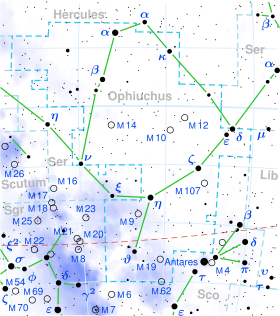| Observation data Epoch J2000 Equinox J2000 | |
|---|---|
| Constellation | Ophiuchus |
| Right ascension | 17h 26m 30.8806s[1] |
| Declination | 4° 08′ 25.2876″[1] |
| Apparent magnitude (V) | 4.31[2] (4.25 - 4.51[3]) |
| Characteristics | |
| Spectral type | K2 III[4] |
| U−B color index | +1.57[2] |
| B−V color index | +1.51[2] |
| Variable type | suspected[3] |
| Astrometry | |
| Radial velocity (Rv) | -27.81[5] km/s |
| Proper motion (μ) | RA: +1.459[6] mas/yr Dec.: +6.760[6] mas/yr |
| Parallax (π) | 3.7578 ± 0.1559 mas[6] |
| Distance | 870 ± 40 ly (270 ± 10 pc) |
| Absolute magnitude (MV) | -2.85[7] |
| Details | |
| Mass | 5–9[8] M☉ |
| Radius | 100±30[8] R☉ |
| Luminosity | 2630±894[8] L☉ |
| Surface gravity (log g) | 1.3±0.5[8] cgs |
| Temperature | 4,129±566[8] K |
| Metallicity [Fe/H] | -0.07[9] dex |
| Rotational velocity (v sin i) | 4.2[10] km/s |
| Other designations | |
| Database references | |
| SIMBAD | data |
Sigma Ophiuchi, Latinized from σ Ophiuchi, is a single,[11] orange-hued star in the equatorial constellation Ophiuchus. Its apparent visual magnitude is 4.31,[2] which is bright enough to be faintly visible to the naked eye. The annual parallax shift of 3.62 mas as seen from Earth provides a distance estimate of roughly 900 light years. It is moving closer to the Sun with a radial velocity of −28 km/s.[5]
This is an evolved giant star of type K with a stellar classification of K2 III.[4] Wittkowski et al. (2017) consider it to have a luminosity class of II-III, suggesting it is in a transitional zone between giants and supergiant stars.[8] It has around 5 to 9 times the mass of the Sun and one hundred times the Sun's radius. The star is radiating 2,600 times the Sun's luminosity from its enlarged photosphere at an effective temperature of 4,130 K.[8]
- ^ a b Brown, A. G. A.; et al. (Gaia collaboration) (August 2018). "Gaia Data Release 2: Summary of the contents and survey properties". Astronomy & Astrophysics. 616. A1. arXiv:1804.09365. Bibcode:2018A&A...616A...1G. doi:10.1051/0004-6361/201833051. Gaia DR2 record for this source at VizieR.
- ^ a b c d Ducati, J. R. (2002). "VizieR Online Data Catalog: Catalogue of Stellar Photometry in Johnson's 11-color system". CDS/ADC Collection of Electronic Catalogues. 2237. Bibcode:2002yCat.2237....0D.
- ^ a b Samus, N. N.; Durlevich, O. V.; et al. (2009). "VizieR Online Data Catalog: General Catalogue of Variable Stars (Samus+ 2007-2013)". VizieR On-line Data Catalog: B/GCVS. Originally Published in: 2009yCat....102025S. 1. Bibcode:2009yCat....102025S.
- ^ a b Houk, N.; Swift, C. (1999). "Michigan catalogue of two-dimensional spectral types for the HD Stars, Vol. 5". Michigan Spectral Survey. 05: 0. Bibcode:1999MSS...C05....0H.
- ^ a b Famaey, B.; Jorissen, A.; Luri, X.; Mayor, M.; Udry, S.; Dejonghe, H.; Turon, C. (2005). "Local kinematics of K and M giants from CORAVEL/Hipparcos/Tycho-2 data". Astronomy & Astrophysics. 430: 165–186. arXiv:astro-ph/0409579. Bibcode:2005A&A...430..165F. doi:10.1051/0004-6361:20041272. S2CID 17804304.
- ^ a b c Brown, A. G. A.; et al. (Gaia collaboration) (2021). "Gaia Early Data Release 3: Summary of the contents and survey properties". Astronomy & Astrophysics. 649: A1. arXiv:2012.01533. Bibcode:2021A&A...649A...1G. doi:10.1051/0004-6361/202039657. S2CID 227254300. (Erratum: doi:10.1051/0004-6361/202039657e). Gaia EDR3 record for this source at VizieR.
- ^ Anderson, E.; Francis, Ch. (2012). "XHIP: An extended hipparcos compilation". Astronomy Letters. 38 (5): 331. arXiv:1108.4971. Bibcode:2012AstL...38..331A. doi:10.1134/S1063773712050015. S2CID 119257644. Vizier catalog entry
- ^ a b c d e f g Wittkowski, M.; et al. (January 2017), "VLTI/AMBER spectro-interferometry of the late-type supergiants V766 Cen (=HR 5171 A), σ Oph, BM Sco, and HD 206859", Astronomy & Astrophysics, 597: 16, arXiv:1610.01927, Bibcode:2017A&A...597A...9W, doi:10.1051/0004-6361/201629349, S2CID 55679854, A9.
- ^ Reffert, Sabine; Bergmann, Christoph; Quirrenbach, Andreas; Trifonov, Trifon; Künstler, Andreas (2015). "Precise radial velocities of giant stars". Astronomy & Astrophysics. 574: A116. arXiv:1412.4634. Bibcode:2015A&A...574A.116R. doi:10.1051/0004-6361/201322360. hdl:10722/215277. S2CID 59334290. Vizier catalog entry
- ^ De Medeiros, J. R.; Mayor, M. (1999). "A catalog of rotational and radial velocities for evolved stars". Astronomy and Astrophysics Supplement Series. 139 (3): 433. arXiv:astro-ph/0608248. Bibcode:1999A&AS..139..433D. doi:10.1051/aas:1999401. Vizier catalog entry
- ^ Eggleton, P. P.; Tokovinin, A. A. (September 2008), "A catalogue of multiplicity among bright stellar systems", Monthly Notices of the Royal Astronomical Society, 389 (2): 869–879, arXiv:0806.2878, Bibcode:2008MNRAS.389..869E, doi:10.1111/j.1365-2966.2008.13596.x, S2CID 14878976.

